The process of taking oxygen into the cells, using it for enrgy release & then eliminating the waste products
like CO2 & H2O is known as respiration.
It is a very slow process. A number of enzyme help in the process of respiration.
The process of taking in O2 rich air into the lungs & giving out carbon dioxide rich air is known as breathing.
Breathing process include 2 steps -
1.Inhalation :
The process of taking in air is called inhalation.
2.Exhalation :
Giving out of air is called exhalation.
Breathing involves only exchange of gases.
DIFFERENCE BETWEEN BREATHING & RESPIRATION
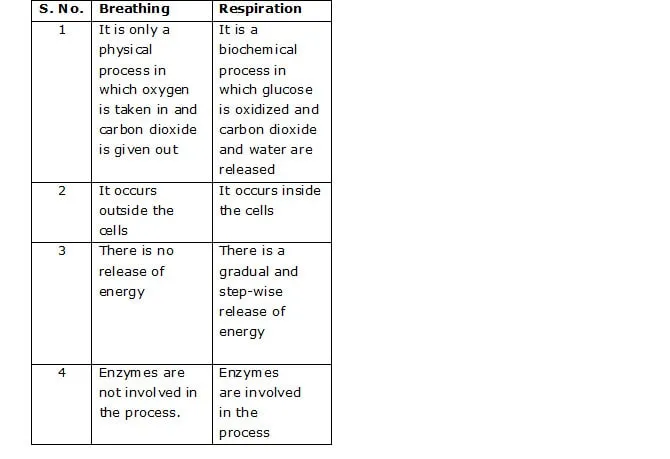
TYPE OF RESPIRATION
There are 2 types of respiration
I Aerobic respiration :
![]()
II Anaerobic respiration :
![]()
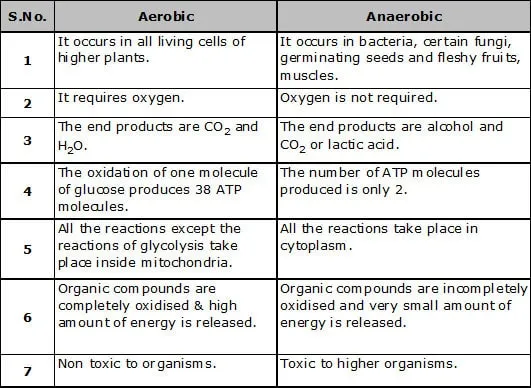
ANAEROBIC RESPIRATION IN HUMAN
![]()
I Stomal Apparatus :
a. A stomatal opening surrounded with two guard cells and several subsidiary cells is called stomatal apparatus.
The opening and closing of the stomata is brought about by the expansion and contraction of the guard cells. Guard cells
expand and contract due to the flow of water in and out of the cells. The exchange of gases in plants is not as fast as in animals. ![]()
. 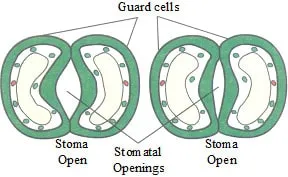
b. Plant roots also respire. Roots take in oxygen from the air present between the soil particles.
c. Some of the woody stems take in air through openings called lenticels.
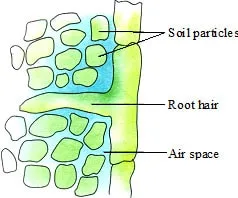
d. Respiration through moist skin
Eg. Frog & Earthworm
e. Respiration through cell membrane
Eg. Amoeba
f. Respiration through Spiracles
Eg. Cockroach
g. Respiration through gills
Eg. Fishes
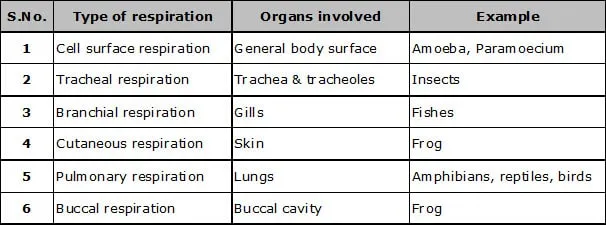
The respiratory system in human beings concsists of the following organs
A Nasal Cavity :
i Air enters the nose through the nostrils and reaches the nasal cavity.
B Larynx :
i The nasal cavity leads into the pharynx. From the pharynx air passes into a rectangular chamber called larynx
C Trachea :
i. The trachea or wind pipe is a delicate muscular tube situated in the front of the neck. It is 12 cm in length and 2.5 cm in diameter.
The trachea divides into two bronchi.
D Bronchi :
i Each bronchus leads to the lungs of its own side. Each bronchus then branches into smaller tubes known as bronchioles.
They end in tiny globules called air sacs or alveoli where exchange of gases takes place.
E Lungs :
i. Lungs are two in number and are present in the chest cavity of the body. Air sacs are richly supplied with blood vessels.
When air enters the lungs, the blood takes in oxygen and gives out carbon dioxide and water
ii Blood carries oxygen to all parts of the body from the lungs.
iii When we exhale, the carbon dioxide rich air follows the reverse route finally moving out through the nose as shown below.
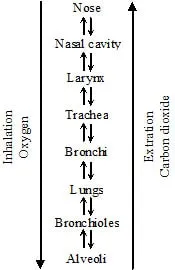
iv Breathing takes place with the help of the intercostal muscles between the ribs and the diaphragm. When we breathe in, the intercostal
muscles contract and the ribs are pushed outwards. The chest cavity becomes larger and the air rushes into the lungs.
v During breathing out, the intercostal muscles relax and the ribs move inwards. The chest cavity shrinks and the air containing carbon
dioxide is pushed out of the lungs.
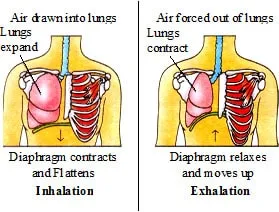
F Breathing rate : The number of times a person breathes in a minute is termed as the breathing rate. The normal breathing rate
in adult at rest ranges from 12 to 20.
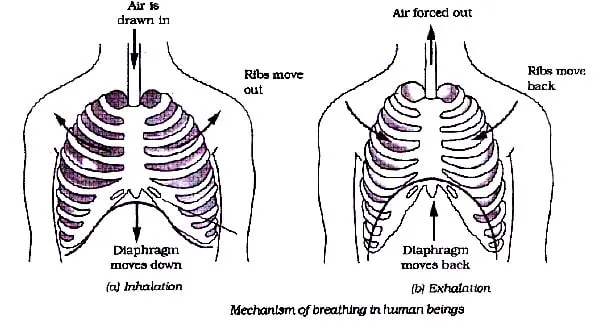
Q.1 How do unicellular organisms exchange gases with the environment?
Q.2 Name the respiratory organs present in the leaves and woody stems.
Q.3 Why do body cells require oxygen?
Q.4 What brings oxygen to all parts of our body?
Q.5 What happens to your breathing rate when you do exercise?
Q.6 Name the respiratory organs of human's respiratory system.
Q.7 What is anaerobic respiration?
Q.8 What happens during cellular respiration?
Q.9 Under what conditions does anaerobic respiration take place in humans?
Q.10 What is the importance of nostrils during breathing?
Q.11 What do you understand by tidal volume?
Q.12 Give a brief account of the various modes of respiration found in animals
Q.13 Draw a neat labelled diagram of respiratory system of man
Q.14 Give four differences between aerobic and anaerobic respiration
Q.15 What is the role of stomatal apparatus in plant respiration?
Q.1 The air sacs at the end of the smallest air tubes inside the lungs are called.
(A) alveoli (B) bronchi
(C) bronchioles (D) larynx
Q.2 Glucose is oxidised to ethyl alcohol in -
(A) aerobic respiration
(B) anaerobic respiration
(C) fermentation
(D) none of these
Q.3 Normal range of breathing rate in an average adult person at rest is -
(A) 9 to 12 (B) 15 to 18
(C) 12 to 20 (D) 30 to 33
Q.4 Plants get their oxygen requirement for respiration through -
(A) stomata
(B) lenticels
(C) both (A) and (B)
(D) None of these
Q.5 Which one of the following can respire in the absence of oxygen? -
(A) fish (B) frog
(C) yeast (D) Man
Q.6 An animal breathe through skin as well as lungs is -
(A) frog (B) Earthworm
(C) snail (D) fish
Q.7 Air tube of an insect is called -
(A) Spiracle
(B) larynx
(C) pharynx
(D) gills
Q.8 During inhalation the diaphragm moves -
(A) upwards
(B) downwards
(C) towards left
(D) towards right
Q.9 During exhalation the ribcage moves -
(A) upward and outward
(B) downwards and inwards
(C) from side to side
(D) does not move at all
1. A 2. B 3. C 4. C
5. C 6. A 7. A 8. B
9. B
1. Energy accumulate in ATP in
(a) Disulphide bond
(b) Hydrogen bonds
(c) High energy phosphate bond
(d) Ester bond
2. In plants, respiration takes place
(a) Only in leaves during night
(b) Only in leaves during day
(c) In all living cells
(d) None of the above
3. Which of the following show higher rate of respiration
(a) Collenchyma (b) Leaf
(c) Dry seeds (d) Germinating seeds
4. C2 cycle is studied in
(a) C4 plants
(b) Those showing photorespiration
(c) Both (a) and (b)
(d) None of the above
5. Respiration is a
(a) Photochemical oxidation
(b) Oxidation reaction
(c) Photophosphorylation
(d) None of the above
6. On which substrate enzyme lipase works
(a) Fat (b) Protein
(c) Carbohydrate (d) All the above
7. Which of the substrate is used in protoplasmic respiration
(a) Fat (b) Carbohydrate
(c) Protein (d) All the above
8. Which of the following leaves will show maximum rate of respiration
(a) Young leaves (b) Mature leaves
(c) Senescent leaves (d) None of the above
9. For which of the following process presence of chlorophyll is not necessary
(a) Photosynthesis (b) Photorespiration
(c) Respiration (d) None of the above
10. Respiration is essential for
(a) Cell division
(b) Conversion of insoluble food to soluble
(c) Maintaining balance of carbon cycle
(d) All the above
11. Pseudomonas saccharophila shows which of the following pathway
(a) Glycolysis
(b) Kreb’s cycle
(c) Entner–Doeudoroff pathway
(d) None of the above
12. In both aerobic and anaerobic respiration which same product is formed
(a) Lactic acid (b) Pyruvic acid
(c) Citric acid (d) Organic acid
13. When a man enters a seed godown, the feeling is that of
(a) Freshness
(b) Suffocation
(c) Freshness in the beginning and suffocation afterwards
(d) Suffocation in the beginning and freshness afterwards
14. During aerobic respiration, the main thing required is
(a) Nitrogen (b) O2
(c) O2 and some microbes (d) None of the above
15. Which of the following is reverse of photosynthesis
(a) Respiration (b) Protein synthesis
(c) Fat synthesis (d) All the above
16. During respiration, there is
(a) Loss of weight
(b) Gain in weight
(c) The weight remain constant
(d) Not applicable
17. The process of phosphorylation takes place in
(a) Glycolysis (b) Kreb’s cycle
(c) HMP pathway (d) All the above
18. “Mitchell’s chemiosmotic theory” belongs to
(a) Kreb’s cycle
(b) Oxidative phosphorylation
(c) Glycolysis
(d) None of the above
19. Match the given below organelles with their function
(a) Kreb’s cycle (i) Stalked particles of mitochondria
(b) Photorespiration (ii) Cytoplasm
(c) Oxidative (iii) Peroxisomes
phosphorylation
(d) Glycolysis (iv)Inner surface of membrane of
mitochondria
A B C D
(a) (ii) (iii) (iv) (i)
(b) (i) (ii) (iii) (iv)
(c) (iv) (iii) (i) (ii)
(d) (iii) (ii) (iv) (i)
20. Match the name of scientist with his work
(a) PPP (Pentose phosphate pathway)
(b) Demonstration of fermentation
(c) TCA cycle
(d) Glycolysis
(i) Kuhne
(ii) Kreb’s
(iii) Warburg–Dickens pathway
(iv) Embden Mayerhof Parnas
A B C D
(a) (i) (ii) (iii) (iv)
(b) (ii) (iv) (iii) (i)
(c) (i) (ii) (iv) (iii)
(d) (iii) (i) (ii) (iv)
21. Match the correct answers with type of respiration and respiratory substrates
Respiration
(a) Floating respiration
(b) Cytoplasmic respiration
(c) Protoplasmic respiration
(d) Lactic acid fermentation
Type of substrate
(i) Proteins
(ii) Starch
(iii) Carbohydrates
(iv) Lactose
A B C D
(a) (iii) (ii) (i) (iv)
(b) (ii) (iii) (iv) (i)
(c) (i) (ii) (iii) (iv)
(d) (ii) (iv) (i) (iii)
22. What is the normal value of extinction point
(a) 20% O2 (b) 2% O2
(c) 10% O2 (d) 30% O2
23. Pneumatophores are responsible for a kind of respiration mainly present in
(a) Hydrophytes (b) Mangroove plants
(c) Epiphytes (d) Xerophytes
24. The plants similar to animals in their requirement of oxygen for cellular respiration belongs to
(a) Red algae (b) Blue–green algae
(c) Fungi (d) Lichens
25. In aerobic respiration
(a) Glucose is the only substrate
(b) Glucose is a preferred substrate
(c) Glucose cannot be used directly
(d) Any material which burns in air can be used as substrate
26. The tissue of highest respiratory activity is
(a) Meristems (b) Ground tissue
(c) Phloem (d) Mechanical tissue
27. Which of the following is a more accurate statement about respiration
(a) O2 must always be available for respiration
(b) O2 combines with carbon to form CO2
(c) O2 combines with hydrogen to form H2 O
(d) Air is inhaled and exhaled only from stomata
28. Respiration differs from combustion in which of the following
(a) Energy is released in respiration
(b) Substance is oxidised
(c) Enzymes are involved
(d) All the above
29. CO2 is constantly released in respiration yet its level remains fairly uniform because
(a) CO2 is used as a buffer
(b) CO2 is utilized in photosynthesis
(c) CO2 is converted into carbonate rocks
(d) CO2 undergoes regular photolysis
30. The energy stored in glucose basically comes from
(a) Air (b) Water
(c) Sun (d) Respiration
31. Aerobic respiration is called
(a) Fermentation (b) Chemosynthesis
(c) Bio–oxidation (d) Photorespiration
32. Old trees obtain O2 from
(a) Stomata (b) Lenticels
(c) Leaf scars (d) All the above
33. Apple and potato obtain O2 through
(a) Stomata (b) Cork
(c) Lenticels (d) Epidermis
34. Respiratory exchange of gases in hydrophytes occur through
(a) Stomata (b) Cuticle
(c) Lenticels (d) General surface
35. Roots of a plant when kept in a phenolphthalein containing weak alkaline solution, decolorises it. This is due to
(a) Absorption of phenolphthalein
(b) Absorption of alkali
(c) Respiration of roots
(d) Utilization of O2
36. Respiratory exchange in seeds occur through
(a) Testa (b) Stomata
(c) Micropyle (d) Hilum
37. Compensation point is developed in
(a) Day light (b) Twilight
(c) Night time (d) Noon hours
38. Protein is used as respiratory substrate only when
(a) Carbohydrates are absent
(b) Fats are absent
(c) Both exhausted
(d) Fats and carbohydrates are abundant
39. When 100% carbon is oxidized to CO2, the efficiency of such a respiration is
(a) 40% (b) 60%
(c) 90% (d) 100%
40. In a mango tree, metabolic energy is most extensively used in
(a) Cambium (b) Crok
(c) Xylem (d) Root parenchyma
41. Which of the following process is immediately affected by the loss of ATP
(a) Diffusion (b) Osmosis
(c) Uptake (d) Kreb’s cycle
42. The rate of respiration could be checked by
(a) Malonate
(b) CO2
(c) Chloroform and cynides
(d) All the above
43. If a starved plant is provided with glucose, the rate of respiration would
(a) Decrease (b) Increase
(c) Become constant (d) First rise and than fall
44. Oxidative phosphorylation is related to the formation of
(a) ATP by chloroplast via photosynthesis
(b) ATP by chondriosome via photolysis
(c) ATP by cytoplasm via glycolysis
(d) ATP by chondriosome via respiration
45. Both respiration and photosynthesis require the following
(a) Sunlight (b) Chlorophyll
(c) Glucose (d) Cytochrome
46. After respiration, the conversion of energy is mainly in the form of
(a) ADP (b) ATP
(c) AMP (d) Glucose
47. The end products of respiration in plants are
(a) CO2, H2O and energy (b) Starch and O2
(c) Sugar and O2 (d) H2O and energy
48. Energy obtained by cell from catabolism is stored immediately in the form of
(a) ATP (b) DNA
(c) Glucose (d) Pyruvic acid
49. Common immediate source of energy in cellular activity or Energy currency of the cell is
(a) DNA (b) ATP
(c) RNA (d) NAD
50. Evolution of CO2 is more than intake of oxygen when
(a) Sucrose is respired
(b) Glucose is respired
(c) Organic acids are respired
(d) Fats are respired
51. The net gain of energy from one gram molecule of glucose during aerobic respiration is
(a) 2 ATP (b) 36 ATP
(c) 38 ATP (d) 15 ATP
52. If carbon dioxide contents of the atmosphere is as high as 300 ppm
(a) All plants will be killed
(b) The plants would not grow properly
(c) Plants would grow for some times and then die
(d) The plants would thrive well
53. Different steps in respiration are controlled by
(a) Auxin (b) Sugar
(c) Enzyme (d) Kinetin
54. To a living organism which of the following has the greater amount of available energy per molecule
(a) ATP (b) ADP
(c) CO2 (d) H2O
55. Which cell organelle is required in photorespiration
(a) Chloroplast (b) Mitochondria
(c) Peroxisome (d) All the above
56. Instantaneous source of energy is
(a) Glucose (b) Fats
(c) Proteins (d) Amino acids
57. Energy given by one molecule of ATP is
(a) 7.3 kcal (b) 721 kcal
(c) 760 kcal (d) 1000 kcal
58. Respiration is an
(a) Endothermic process (b) Exothermic process
(c) Anabolic process (d) Endergonic process
59. Who among the following can be said to be the “Father of Indian Physiology”
(a) B.P. Pal (b) K.C. Mehta
(c) M.S. Swaminathan (d) J.C. Bose
60. The energy yield as a result of total oxidation of one glucose molecule during cellular respiration is to convert
(a) 38 molecules of ADP into 38 molecules of ATP
(b) 30 molecules of ADP into 30 molecules of ATP
(c) 36 molecules of ADP into 36 molecules of ATP
(d) 32 molecules of ADP into 32 molecules of ATP
61. The synthesis of ATP in photosynthesis and respiration is essentially an oxidation–reduction process involving removal of energy from
(a) Oxygen (b) Phytochrome
(c) Cytochrome (d) Electrons
62. TPP means
(a) Thiamine pyrophosphate
(b) Thymine pyrophosphate
(c) Thymine pentaphosphate
(d) None of the above\
63. The connecting link among glycolysis, Kreb’s cycle and beta–oxidation of fatty acid is
(a) Pyruvic acid (b) Acetyl CoA
(c) Acetaldehyde (d) Citric acid
64. Aerobic respiration of glucose produces energy
(a) 637 kcal (b) 640 kcal
(c) 673 kcal (d) 693 kcal
65. Respiration occurs
(a) Only in non-green cells in light
(b) Only in non-green cells both in light and dark
(c) In all living cells both in light and dark
(d) In all living cells only in light
66. In plants, energy is produced during the process
(a) Transpiration (b) Respiration
(c) Photosynthesis (d) Water absorption
67. Which of the following is the source of respiration
(a) Stored food (b) RNA
(c) DNA (d) ATP
68. In the process of respiration the potential energy stored in the organic compounds is released in the form of
(a) Kinetic energy (b) Physical energy
(c) Chemical energy (d) Radiant energy
69. Carbon dioxide liberates during
(a) Ascent of sap (b) Transpiration
(c) Photosynthesis (d) Respiration
70. What is the importance of respiration in plants
(a) It provides oxygen to plants
(b) It liberates energy
(c) It liberates carbon dioxide
(d) All the above
71. Aerobic respiration is more advantageous to a large organism than anaerobic respiration, because aerobic respiration
(a) Does not require sunlight
(b) Produces oxygen as a waste product
(c) Does not require molecular oxygen and hydrogen
(d) Releases more energy from an equal amount of nutrients
72. Intake of CO2 and outlet of O2 is equal in photosynthesis and respiration, then the condition is known as
(a) Red drop (b) Solarization
(c) Null point (d) Compensation point
73. During 24 hours there is a time when plants neither give O2 nor CO2. This is the time of
(a) Night (b) Daylight
(c) Twilight (d) None of these
74. If CO2 is given off in respiration, why does the amount of CO2 in the atmosphere remains relatively constant
(a) CO2 forms carbonate rocks
(b) CO2 is buffer
(c) CO2 is converted in photosynthesis to carbohydrates
(d) CO2 splits up during photosynthesis
75. Respiration is a process in which
(a) Energy is used up
(b) Energy is stored in the form of ATP
(c) Energy is released and stored in the form of ATP
(d) Energy is released at all
76. Respiration differs from the process of combustion in the fact that
(a) All the energy stored in glucose is released at once due to combustion
(b) All energy stored in glucose is gradually released due to combustion
(c) Comparatively large quantity of energy is produced due to combustion
(d) The carbohydrates act as the combustion substance
77. Oxidative phosphorylation occurs during the process of
(a) Protein synthesis (b) N2 fixation
(c) Respiration (d) Transpiration
78. Cut surfaces of fruit and vegetables often become dark because
(a) Dirty knife makes it dark
(b) Oxidation of tannic acid in the presence of trace of iron from the knife makes it dark
(c) Dust of the air makes it dark
(d) None of the above
79. Cytochrome is related to
(a) Cellular digestion (b) Protein synthesis
(c) Cell division (d) Cellular respiration
80. Which of the scientific paper would you assign to plant physiology
(a) Evergreen forest of India
(b) Embryo culture of plants
(c) Respiratory activities in plants
(d) Cell and cell division
81. When ATP is converted into ADP, it releases
(a) Electricity (b) Energy
(c) Enzymes (d) Hormones
82. Leaves of annual plants obtain O2 through
(a) Cell walls (b) Cuticle and leaf scars
(c) Stomata (d) Lenticels
83. Adenosine diphospate contains
(a) One high energy bond
(b) Two high energy bond
(c) Three high energy bond
(d) Four high energy bond
84. Heat energy of plants is measured in
(a) Grams (b) Pounds
(c) Decibels (d) Calories
85. Enzymes related with cristae are related with
(a) Anaerobic respiration
(b) Aerobic respiration
(c) CO2 formation
(d) Reduction of pyruvic acid
86. Highest calories is obtained from
(a) Fats (b) Proteins
(c) Carbohydrates (d) Vitamins
87. In oxidative phosphorylation, oxidation and phosphorylation take place simultaneously and form
(a) NADP (b) DPN
(c) Pyruvic acid (d) ATP
88. Make suitable pairing
(A) Glycolysis (a) Mitochondria
(B) Kreb’s cycle (b) Cytoplasmic matrix
(C) Electron transport chain
(a) Aa, Ba, Cb (b) Ab, Ba, Ca
(c) Aa, Bb, Cb (d) Ab, Bb, Ca
89. The amount of energy released in complete oxidation of one molecule of glucose is
(a) 628 kcal (b) 668 kcal
(c) 686 kcal (d) 697 kcal
90. The mechanism of ATP formation both in chloroplast and mitochondria is explained by
(a) Relay pump theory of Godlewski
(b) Cholodny-Wont’s model
(c) Chemiosmotic theory
(d) Munch’s hypothesis (mass flow model)
91. Which of the following is formed during respiration
(a) O2 (Oxygen)
(b) CO2 (Carbon dioxide)
(c) NO2 (Nitrogen dioxide)
(d) SO2 (Sulphur dioxide)
92. Net gain of ATP molecules, during aerobic respiration, is
(a) 36 molecules (b) 38 molecules
(c) 40 molecules (d) 48 molecules
93. In mitochondria, cristae act as sites for
(a) Protein synthesis
(b) Oxidation-reduction reaction
(c) Breakdown of macromolecules
(d) Phosphorylation of flavoproteins
94. The energy consumed during the conversion of ADP into ATP is
(a) 73000 cal/mole (b) 686000 cal/mole
(c) 8000 cal/mole (d) 7300 cal/mole
95. Which of the following is the phosphorylating unit
(a) Oxysome (b) Mesosome
(c) Peroxisome (d) Mitochondria
96. Cristae helps in
(a) Respiration (b) Transpiration
(c) Photosynthesis (d) Photo-oxidation
97. Cristae are associated with which of the following
(a) Cytoplasm (b) Protoplasm
(c) Mitochondria (d) Ribosomes
98. From substrate level phosphorylation ATP are produced
(a) 2 (b) 6
(c) 10 (d) 8
99. The net gain of energy, from one molecule of sucrose in aerobic respiration, is
(a) 18 ATP (b) 38 ATP
(c) 60 ATP (d) 80 ATP
100. The high-energy bonds of ATP are between
(a) C-C (b) C-O
(c) C-N (d) O-P
1 c 2 c 3 d 4 b 5 b
6 a 7 c 8 a 9 c 10 d
11 c 12 b 13 b 14 b 15 a
16 a 17 d 18 b 19 c 20 d
21 a 22 b 23 b 24 c 25 b
26 a 27 c 28 c 29 b 30 c
31 c 32 d 33 c 34 d 35 c
36 c 37 b 38 c 39 a 40 a
41 c 42 d 43 b 44 d 45 d
46 b 47 a 48 a 49 b 50 c
51 c 52 d 53 c 54 a 55 d
56 a 57 a 58 b 59 d 60 a
61 d 62 a 63 b 64 c 65 c
66 b 67 a 68 c 69 d 70 b
71 d 72 d 73 c 74 c 75 c
76 b 77 c 78 b 79 d 80 c
81 b 82 c 83 a 84 d 85 b
86 a 87 d 88 b 89 c 90 c
91 b 92 a 93 b 94 d 95 a
96 a 97 c 98 b 99 d 100 d